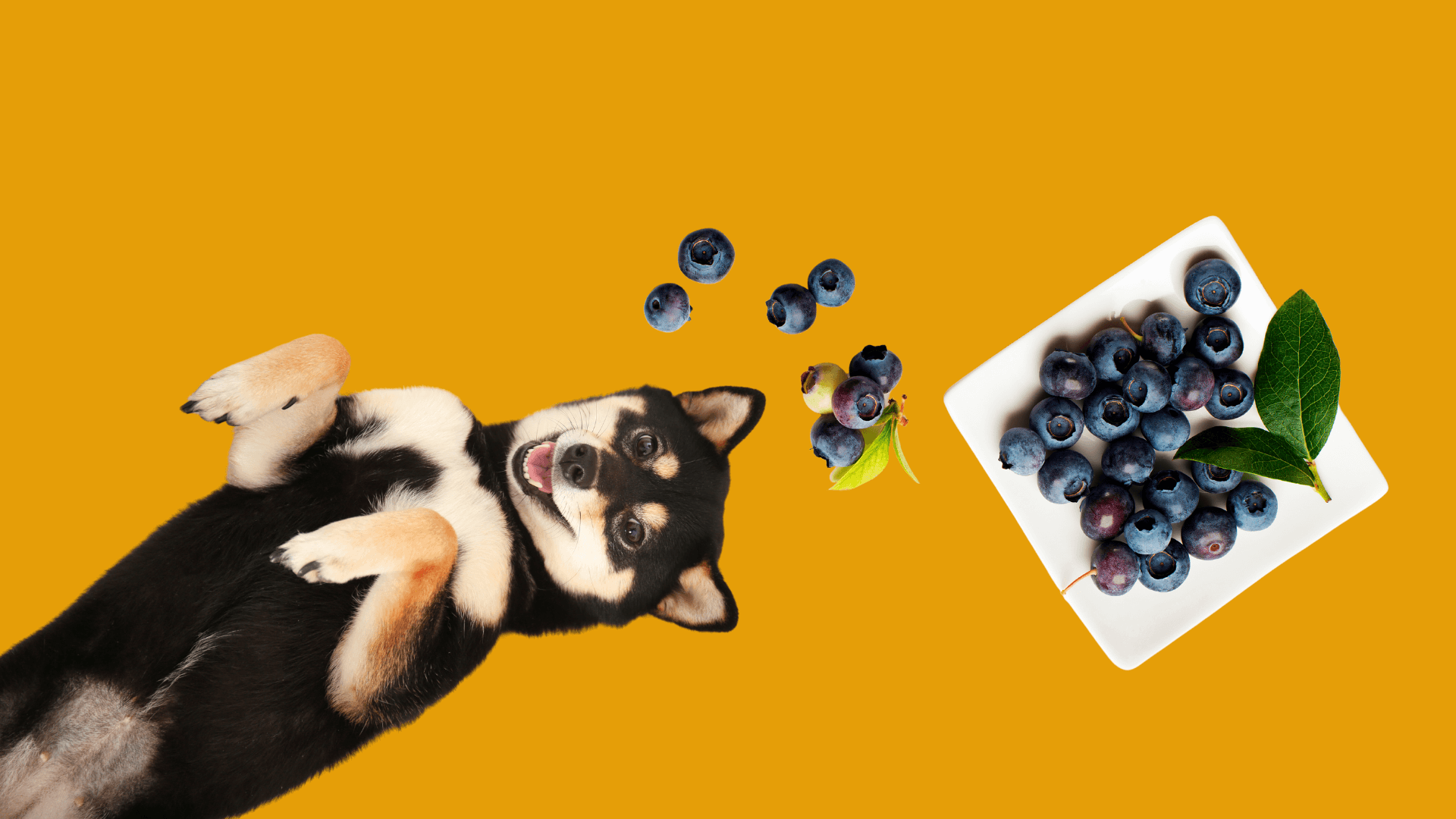Thinking of adding blueberries to your dog’s diet? As we strive to give our lovely pets the best, it’s essential to know what’s safe and beneficial for them. In this blog post, we’re diving into the big question: Can dogs eat blueberries?
We’ll crack the case on whether these antioxidant-packed snacks are safe and even beneficial for our pup. Plus, I’ll dish out tips on serving sizes and sneaky ways to incorporate blueberries into our lovely dog’s day.
So grab a handful of berries (and maybe a treat for your pup!), cozy up, and get ready to unleash the paw-sitive power of blueberries! We’ll have you saying “blue-tiful” in no time.
Can Dogs Eat Blueberries?
Dogs can eat Blueberries in moderation; it’s a Big Yes!
Unlike some fruits that can be toxic to dogs, blueberries are a healthy and safe treat for most pups. They’re packed with antioxidants, vitamins, and fiber, making them a nutritious little boost to our dog’s diet.
What are the Benefits of Blueberries to Dogs?

As I said, Blueberries can offer several health benefits to our dogs when included as part of their balanced diet. Some of the potential benefits include:
Rich in Antioxidants
Blueberries are packed with antioxidants, such as anthocyanins, which can help neutralize free radicals in the body. This can contribute to overall cellular health and may have anti-inflammatory effects.
Vitamins and Minerals
Blueberries contain essential vitamins like vitamin C and vitamin K. Vitamin C is important for the immune system, while vitamin K plays a role in blood clotting.
Fiber
Blueberries are a good source of dietary fiber, which can aid in digestion and help maintain a healthy digestive system.
Low in Calories
Blueberries are relatively low in calories, making them a healthy and low-fat treat option, especially for dogs on a calorie-restricted diet.
Brain Health
Some studies suggest that the antioxidants in blueberries may have cognitive benefits, potentially supporting brain health in aging dogs.
Hydration
Blueberries have a high water content, about 85%, contributing to your dog’s overall hydration when consumed.
But Wait, There’s More!
Blueberries aren’t just a tasty treat; they can also be a fun and rewarding training tool. Their small size makes them perfect for positive reinforcement, and their sweetness is sure to keep our lovely dogs motivated.
Things to Consider When Feeding Blueberries to Dogs

When feeding blueberries to dogs, there are several important considerations to keep in mind to ensure the safety and well-being of our lovely pets:
Feed in Moderation
While blueberries are a healthy treat, moderation is key. Too many blueberries can lead to digestive upset or diarrhea due to their natural sugars. As a guideline, treats and snacks should only make up about 10% of your dog’s daily caloric intake.
Learn Proper Preparation
Wash blueberries thoroughly to remove any pesticides or contaminants. Remove stems, and for smaller dogs, consider cutting or mashing the blueberries to prevent choking.
Consider if Your Dog Has Allergies
Some dogs may be allergic to certain foods, including blueberries. Introduce them gradually and monitor your dog for any signs of an allergic reaction, such as itching, swelling, or gastrointestinal distress.
Consider Your Dog’s Health Conditions
If your dog has specific health conditions, such as diabetes or kidney issues, consult with your veterinarian before adding blueberries to their diet. The natural sugars in blueberries may affect blood sugar levels.
Choose Between Frozen vs. Fresh
Both frozen and fresh blueberries are suitable for dogs. Frozen blueberries can be a refreshing treat, especially on hot days. However, be cautious with frozen berries if your dog has dental issues.
Check for Mold
Inspect the blueberries for mold or signs of spoilage before offering them to your dog. Moldy berries can be harmful and cause various health issues.
Other Ingredients
Feeding blueberry-flavored products, such as treats or yogurt, check the ingredient list. Some products may contain added sugars, artificial sweeteners, or other ingredients that are not suitable for dogs.
Weight Management
While blueberries are low in calories, it’s important to consider your dog’s overall diet and weight management. If your dog needs to lose weight, consult with your veterinarian to determine the appropriate treat allowance.
Always monitor your dog when introducing new foods, including blueberries, and be attentive to any changes in behavior or health. If you have any concerns or questions about your dog’s diet, consult with your veterinarian for personalized advice.
How to Serve Blueberries to Dogs?

Serving blueberries to dogs is a simple process, but it’s important to take certain precautions to ensure your dog’s safety. Here’s a step-by-step guide:
Step 1: Choose Fresh, High-Quality Blueberries:
Opt for fresh, organic blueberries when possible. Ensure that the blueberries are ripe and free from mold or spoilage.
Step 2: Wash the Blueberries & Remove Stems
Rinse the blueberries thoroughly under cold water to remove any pesticides or contaminants.
Take the time to remove the stems from the blueberries, as they can pose a choking hazard.
Step 3: Cut or Mash for Small Dogs
If you have a small dog or a breed prone to choking, consider cutting the blueberries into smaller, bite-sized pieces or mashing them.
Step 4: Introduce Gradually
If your dog has never had blueberries before, introduce them gradually into their diet. Start with a small amount to monitor for any adverse reactions.
Step 5: Incorporate into Meals or Treats
You can mix blueberries into your dog’s regular meals or use them as a special treat during training sessions. Consider adding a few blueberries to their food bowl or using them as a reward for good behavior.
Step 6: Freeze for a Refreshing Treat
Freeze blueberries for a cool and refreshing treat, especially on hot days. Frozen blueberries can provide a satisfying crunch and be a source of hydration.
Step 7: Consider Your Dog’s Size and Health
Adjust the serving size based on your dog’s size. Larger dogs can have a few more blueberries than smaller ones.
If your dog has specific health conditions or is on a special diet, consult with your veterinarian before adding blueberries to their routine.
Step 8: Limit Quantity
While blueberries are a healthy treat, remember to limit the quantity to avoid overfeeding. Treats should make up only a small portion of your dog’s overall diet.
Get Creative with Blueberries!
There are endless ways to incorporate blueberries into your dog’s day. Here are a few ideas:
- Mix them into their kibble.
- Freeze them into homemade dog treats.
- Stuff them into a Kong toy.
- Add them to your dog’s smoothie.
- Hide them in puzzle toys for a fun mental challenge.
With a little creativity, you can easily share the benefits of blueberries with your furry friend. So next time you’re enjoying a bowl of these delicious berries, remember your pup can join in on the fun—in moderation, of course!
I hope this blog post has answered all your questions about dogs and blueberries. Now go forth and spread the blueberry love!
P.S. If you have any concerns about giving your dog blueberries, always consult with your veterinarian. They can help you determine the best way to introduce this healthy treat into your pup’s diet.
Frequently Ask Questions:
Can Dogs Eat Blueberries Muffins?
While plain blueberries are generally safe for dogs in moderation, blueberry muffins may not be the best choice. Muffins often contain ingredients like sugar, butter, and flour, which can be harmful to dogs in excess. Additionally, some muffins may have other ingredients that are not safe for dogs, such as artificial sweeteners or raisins. It’s best to offer your dog fresh, plain blueberries instead of blueberry muffins.
Can Dogs Eat Blueberries Yogurt?
Plain yogurt in moderation is generally safe for dogs, and adding a few blueberries to it can be a healthy treat. However, be cautious about flavored yogurts that may contain added sugars, artificial sweeteners, or other ingredients that could be harmful to dogs. Always check the ingredients and opt for plain, unsweetened yogurt when sharing it with your dog.
Can Dogs Eat Blueberries Waffles?
While plain blueberries are safe for dogs, waffles are typically made with ingredients like flour, sugar, and butter, which are not the healthiest for dogs. Additionally, some waffles may contain additional toppings or syrups that can be harmful. It’s better to avoid giving your dog waffles and instead offer them fresh, plain blueberries as a safer alternative.
Can Dogs Eat Blueberries Everyday?
Yes, in moderation, dogs can eat blueberries every day. Blueberries are a healthy and nutritious fruit for dogs, rich in antioxidants and vitamins. However, it’s important to feed them in moderation as part of a balanced diet.
Too many blueberries or any other treats can contribute to excessive calorie intake and potential digestive issues. Always consult with your veterinarian to determine the appropriate amount of blueberries for your specific dog based on its size, breed, and overall health.




